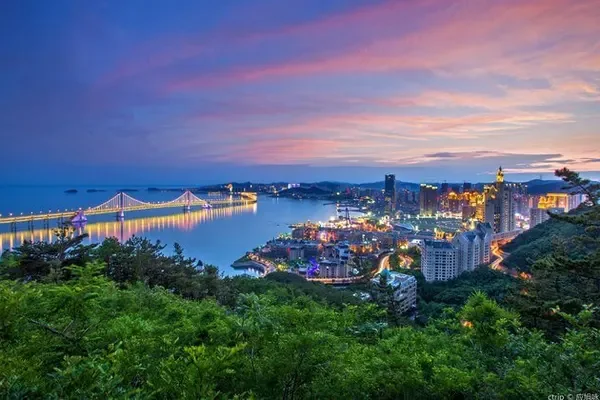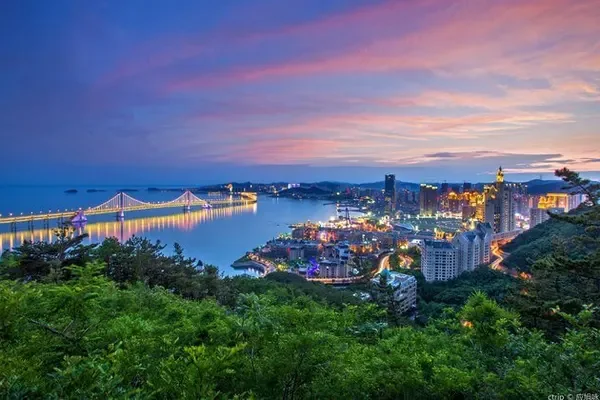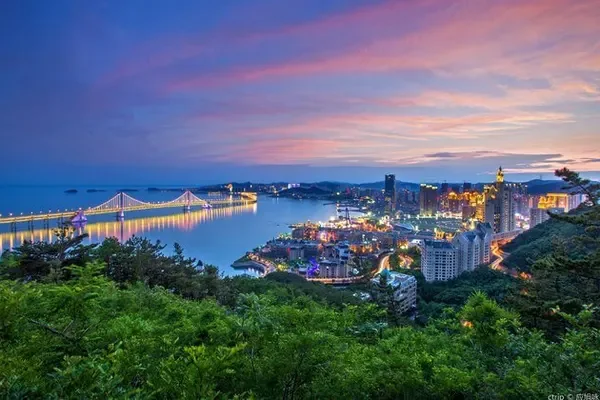【Continued】October 5 (Friday): Weather in Tangshan City: sunny, 21/9 degrees, northwest wind, light wind. Itinerary: from Qiansuo Town to home. Attractions: Qiansuo Ancient City, Qianwei Leaning Tower, Luanzhou Ancient City.

(This is "Suidong Dongdaihe Vacation Apartment", which is actually a rural nursing home)
At 7:50, drive from "Suidong Dongdaihe Holiday Apartment", which is very close to the ancient city of Qiansuo, less than 2 kilometers away.
Located 42 kilometers west of Suizhong County, Qiansuo Ancient City is a national key cultural relics protection unit. The ancient city was built in the third year of Xuande in the Ming Dynasty (1428). It was built by Ye Xing, the commander of Liaodong in the Ming Dynasty. There were 125 fortresses built outside the pass in the Ming Dynasty, and the former fortress is the only one that has been completely preserved. The ancient city is basically square, 510 meters long from east to west, 502 meters wide from north to south, and 10 meters high. There are three gates in east, west and south, and no north gate. There are gate towers built on each city gate, but they have been destroyed by war, and only the bluestone pillar foundations remain. Luo City was originally built at each city gate, but now only Ximen Luo City still exists. There are inclined ladders in the east and west towers, so you can visit the city.



(East Gate of Qiansuo Ancient City - Dingyuan Gate)

(Inside Dingyuan Gate)



(There is a small gate on the north side of Dingyuan Gate. After entering the gate, you can go up to the city gate along the slope trail)



(The gate tower above Dingyuan Gate, the east gate of the former ancient city, is no longer there, and now only the pillar foundations are left. It can be seen that the former gate tower was not big, it was a small gate tower with three rooms horizontally and one room vertically)

(There are no railings on the three gates of Qiansuo Ancient City. Tourists must be careful when walking on them. Standing at Dingyuan Gate and looking east, this is outside the city. It was an important battlefield 400 years ago)

(The west gate of the former ancient city - Yongwang gate, this is the inner side of the west gate)


(This is the outside of the Yongwang Gate leading to the Urn City)




(The Yongwang Gate is not only larger than the East Gate, but also retains the Wengcheng. The outer gate of the Wengcheng is opened on the side, and now small cars are allowed to pass through the Wengcheng.)




(The outer city gate of Yongwangmen, the west gate of Qiansuo ancient city, is not like the outer city gate of Zhengyangmen in Beijing. Yongwangmen and the urn gate are opened on the side)




(The north side of the west gate of Qiansuo Ancient City is also the entrance to the city)






(Wengcheng is one of the main defensive facilities of ancient cities, which can strengthen the defense of castles or passes, and the semicircular or square guard gates built outside the city gate (there are also special cases inside the city gate) belong to ancient Chinese cities. Part of the city wall. The urn of Yongwangmen is a typical semicircular gate city)

(The walls of the Yongwangmen Urn City are relatively thick, and a large number of troops can be stationed on the Urn City)

(Drainage channel on the semicircle wall of Wengcheng)



(The gate tower of Yongwang Gate, the west gate of Qiansuo Ancient City, has also been destroyed. Judging from the remaining plinths, the scale of Yongwang Gate is larger than that of Dingyuan Gate. Although it is also the size of three horizontal rooms and one vertical room, it is obviously There is a colonnade from the front, and there is a gatehouse foundation higher than the ground of the city gate, with steps)
Qiansuo City is the first city outside the pass, occupying key points, and the situation is dangerous. During the war between Ming and Qing Dynasties, the Ming Dynasty sent troops to guard here. At the end of Ming Dynasty, when Yuan Chonghuan was the head of Fang, he was stationed here. In the second Zhifeng War, Zhang Zuolin once used this as the forward stronghold to attack Shanhaiguan. This ancient city located in the western corridor of Liaoning not only reflects the connotation of local history, science and culture, but also reflects the close historical, military, economic and cultural exchanges between northern and southern China. The ancient city of Qiansuo is a typical representative of Suocheng in the Ming Dynasty. It witnessed the military activities in the western Liaoning area in the middle and late Ming Dynasty in detail, and has extremely high historical research value.




(The west city wall of the former ancient city is relatively intact. There are hundreds of meters on the city wall for tourists to walk on, but there are no railings. Walking on it is frightening, and there are still potential safety hazards)


(Walk along the city wall to the end of the protection area, you can see the original rammed earth in the middle of the blue brick city wall, and trees have grown on the rammed earth)

(Outside the city, a small garden was built along the city wall)


(This is a section of the city wall that has not been repaired, and the mottled blue brick wall tells its vicissitudes)

(This section of the exposed city wall can clearly see that the three-component soil used to build the city wall)


(The south gate of Qiansuo Ancient City—Guangding Gate)

(The edge of the Guangdingmen city wall is a bit messy and needs to be improved)
Depart at 8:50, drive northeast along the national highway for more than 20 kilometers, and arrive at the Qianwei Leaning Tower at 9:30, with the odometer reading 1069 kilometers.

Qianwei Town Leaning Pagoda was built in the Liao Dynasty, also known as Ruizhou Ancient Pagoda, a provincial key cultural relics protection unit. The existing tower is 10 meters high, the tower body is inclined 12 degrees to the northeast, and the horizontal displacement of the tower tip is 1.7 meters. After the tower was built, although it was damaged by earthquakes and floods several times, it never fell down. Compared with the Leaning Tower of Pisa in Italy, it is much smaller in scale, but its inclination is higher than that of any leaning tower in China and abroad, and it was built more than 300 years earlier than the Leaning Tower of Pisa.





It is a solid brick pagoda with dense eaves, with stone as the base and bricks as the tower body, which is octagonal in three levels. The crooked pagoda has a single roof, and there was originally a roof on the top, but it has collapsed and is incomplete. Brick carvings of flowers and swastika patterns can be seen on the tower body, and the lines are relatively clear. But the Buddha statues in the niches on the body of the pagoda have been stolen and destroyed. Many of the blue bricks at the bottom of the tower have been artificially demolished. In recent years, for protection, a new blue brick tower base has been built.










Depart by car at 9:45, get on G1 at the Qianwei toll gate, and arrive at the Shanhaiguan service area at 10:27 to rest for 10 minutes. At 11:50, I got off the expressway at the Luanxian toll station, and at 12:30 I arrived at the Laowudao Sliced Noodle Lunch next to the ancient city of Luanzhou. The odometer showed 1228 kilometers.

(Almost every service area on the expressway during the National Day is overcrowded. Friends who drive by themselves must fill up the car before getting on the expressway)
After lunch, drive to the Luanhe Mother Statue on the Luanhe Cultural Square by the Luanhe River to take pictures and enjoy the scenery along the Luanhe River. Then park the car in the parking lot outside the east gate of Luanzhou ancient city, and enter the ancient city from the east gate for sightseeing.






The ancient city of Luanzhou is located in Luanzhou Town, Luan County, Tangshan City. It was rebuilt on the original site in recent years. The east gate looks tall and majestic, but the tower cannot be climbed. Outside the city gate is a square with a stage where some local people are performing opera programs. The base of the city tower is empty inside, and the public toilets, the ancient city visitor center and the intangible cultural heritage exhibition center are built inside, which can be entered from the small gates on both sides of the city gate.



(East Gate Square, Luanzhou Ancient City)

(Luanzhou Ancient City Tourist Service Center is inside the city gate)


(There is a large ancient city sand table in the Tourist Service Center)


(Inside the east gate of Luanzhou Ancient City)
The ancient city is not closed, there are multiple entrances that can be entered free of charge, the antique buildings are antique, and the streets are crowded with pedestrians. This is the most tourist attraction in our itinerary.




Several antique scenic spots in the ancient city are mainly distributed on a main road from the east gate of the city to the big archway in the west of the city. There is also a circular waterway in the city. I feel that the scenery on both sides of the waterway is elegant, and it is a good place to take pictures and view the scenery. Tourists can walk on the waterway by boat, and there is a feeling of swimming in the middle of a painting. We entered from the east gate and visited the Drum Tower, Confucian Temple, Guandi Temple, Zijin Pagoda, Yuelao Pavilion (also called Wenji Tower) along the main road, and then went south to the "Jingdong No. 1 State" Archway, and then walk back to the East Gate parking lot from outside the city.


(Drum Tower)
The layout of the entire ancient city is quite upright, and the appearance of the antique buildings looks relatively high-quality. There is no charge for several small scenic spots, but there are people guarding the gates of the main halls of the Confucian Temple, Guandi Temple, and Yuelao Pavilion. You must pay for incense before entering to meet the main god.

(The Confucian Temple in the ancient city of Luanzhou)

(The Confucian Temple is too ostentatious, unlike the Confucian Temple, like the Temple of Wealth)



l
(The tablet of Confucius is enshrined in the main hall of the Confucian Temple)




(There are many tourists at the gate of Guandi Temple, you can look at the couplets on the gatepost)

(The main hall of Guandi Temple - Chongsheng Hall, there is a man and a woman guarding the door, and they are not allowed to enter the hall without spending money to buy blessing incense)

(I ignored him and broke in)

(pious believers)

(On the east side of this small square is the Drum Tower, on the north side of the square is the Confucian Temple, on the south side is the Guandi Temple, and the photo is facing the north side)
To the west of Guandi Temple is the Zijin Pagoda. The Zijin Pagoda is a seven-story wooden pagoda. You can climb up to the top of the pagoda to overlook the panoramic view of the ancient city, and the scenery on each floor is different. It is worth taking a good look.


(The prayer belts of believers cover all the white marble Buddha statues)











(The waterway around the ancient city seen on the Zijin Pagoda)




(East Street in the ancient city, you can see the Drum Tower, Confucian Temple, Guandi Temple and East Gate)







(You can overlook the panoramic view of the ancient city on the tower)

(Buddha statue in the Zijin Pagoda)









(Purple Gold Pagoda next to the waterway)



(The tourist waterway of the ancient city of Luanzhou, tourists can take a boat tour of the ancient city of Luanzhou)
From the introduction materials, I learned that there are real-life CS, escape room, and wax museum in the ancient city, but I am not very interested in these, so I didn't go there. There are shops and stalls on both sides of the pedestrian road in the ancient city, selling special food, specialty products and tourist souvenirs, which is very lively. The ancient city is not big, and it is not very tiring to walk around. Except for battery sightseeing cars, all motor vehicles and non-motor vehicles are prohibited from passing on the east-west main roads in the city. If you are tired from walking, you can take a sightseeing bus back. The sightseeing bus is privately operated, and the price is not inquired.





(The main street of the ancient city is bustling with tourists, which is the most visited scenic spot in my National Day trip)

(The Great Sage is tired and needs to rest for a while!)



(Two plaques can be seen on this antique building, the second floor reads "Yuelao Temple" and the first floor reads "Wenji Tower")


(Visitors can take the stairs to the second floor, and the Yuelao Temple on the second floor also needs to pay to enter)
At 15:20, I drove away from the ancient city and visited the ancient city for an hour and a half. I had a general feeling about the ancient city. This is a completely reconstructed ancient city, only the scenic spots have no cultural relics. Compared with the ancient city of Shangqiu that I visited just a week ago, although it looks splendid, it does not feel the heavy sense of history at all. Of course, it can be used as a film and television base.

(In many places in the ancient city, there is a game activity called "wrestling bowl wine". Tourists spend money to throw bowls to pray for blessings)






(The ancient city of Luanzhou is not a closed ancient city surrounded by city walls. There are several tall archways on the south side, and you can also enter the city from here)
At 15:20, I left the ancient city of Luanzhou and embarked on the journey home. Tangshan is a large industrial city, and I also feel the characteristics of an industrial city here. According to the guidance of the mobile phone navigation, we first walked the G205 National Highway for more than 20 kilometers. There were a lot of large vehicles, the congestion was serious, and the road conditions were also very poor. Then take the Tangshan Ring Road, and get on the Tangjin Expressway at the Tangshan East Toll Station at 17:00, and the odometer shows 1280 kilometers. 17:15 Rest in the Fengrun service area, go to the toilet, add boiling water, and wash fruits. Then take Jingha Expressway, Tangcheng Expressway, Jingqin Expressway, Sixth Ring Road, Jingping Expressway, Jingcheng Expressway, North Fifth Ring Road, and arrive home at 20:45, with an odometer of 1503 kilometers.
This time, the highway back to Beijing by self-driving from western Liaoning was very smooth. It may be that it was just October 5th, and it hadn’t reached the peak of the return journey during the Golden Week, so there was no congestion along the way. G1N Jingqin Expressway is a highway that has just opened to traffic. Not only are there few vehicles, but there is no checkpoint for entering Beijing all the way to the Sixth Ring Road. But my car is not very powerful this time, and the accelerator is weak from time to time. No matter how hard I step on it, the speed can only reach 90 kilometers per hour. I have to stop at the service area or emergency parking belt and turn off the engine for a few minutes before it can be recovered, and the oil warning light is also on. Yes, the engine shakes a bit too. Just drive for half an hour, stop for two minutes, drive again, and stop again. After I got home and asked my friends, I found out why. It turned out that I bought a fuel treasure before my trip. This trip is the first time I use a fuel treasure for this car. These problems are caused by the carbon deposits falling off in the cylinder and poor oil passage. These symptoms are similar to those described in the fuel treasure introduction materials. The instructions are exactly the same. So here is also a reminder to donkey friends, if the car has not been filled with fuel for a long time, it must not be used during long-distance self-driving, so as to avoid the failure of the vehicle's oil circuit. 【End of the full text】


